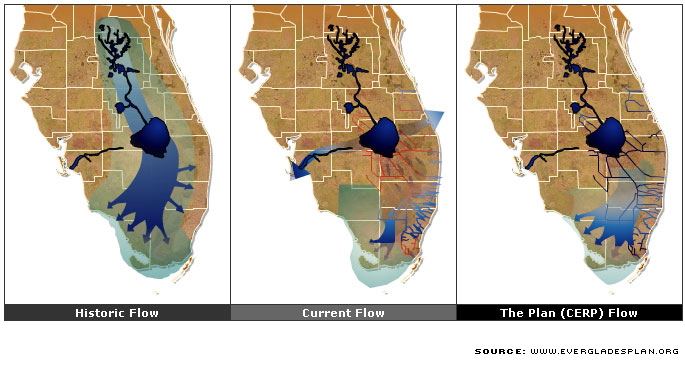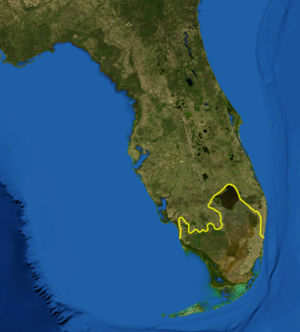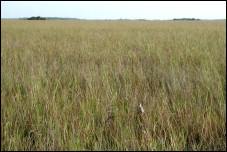Overview
The Everglades was an immense ecosystem that once covered about 3,000,000 acres in Florida. Originally, the hydrology of the area was such that a shallow sheet of water flowed through sawgrass and nourished wetlands. In 1948, the government began to drain the wet areas, erected levies, and dug canals in order to clear room for agriculture and cities. This alteration controlled flooding and created land usable by humans but unfortunately had a number of negative side effects including: destruction of over 50% of the original Everglades, increase freshwater runoff into the ocean, and decreased water quality.
In 2000, Congress approved the Comprehensive Everglades Restoration Plan (CERP) that provides funding for alterations to existing structures and addition of new structures (reservoirs, channels, etc.) that attempt to re-create the effect of the original water flow. This restoration will positively impact the Everglades and oceanic ecosystems as well as providing benefits to people.
Quick Facts
Project Location:
Everglades, Florida, USA, 25.745929, -80.55495610000003
Geographic Region:
North America
Country or Territory:
United States of America
Biome:
Freshwater
Ecosystem:
Freshwater Ponds & Lakes
Area being restored:
18,000 Square miles
Organization Type:
Governmental Body
Location
Project Stage:
Implementation
Start Date:
2000-12-11
End Date:
2000-12-11
Primary Causes of Degradation
Urbanization, Transportation & IndustryDegradation Description
An astonishing 50% of the original Everglades are already destroyed due to changes in the hydrologic regime and urbanization.
In 1948, Congress initiated the Central & Southern Florida Project (C&SF Project). This project allowed the U.S Army Corps of Engineers and the South Florida Water Management District to construct a complicated water management system that drained, levied, and altered the wetlands to prevent flooding and provide irrigation for crops. This project allowed humans to come into Florida in large numbers both for agriculture and to build cities.
But this altered flow and timing of water dried up many of the Everglades wetlands entirely, which resulted in habitat loss and reduced water quality. This alteration also resulted in tremendous loss of freshwater into the ocean (about 1.7 billion gallons), which has hurt the ecosystems and inhabitants of both land and ocean.
Reference Ecosystem Description
The Everglades was a huge area, home to countless species of birds, wildlife, fish, and plants. The Everglades also provides a stopover point for migratory birds.
Originally, the Everglades hydrology consisted of a giant, mostly uninterrupted sheetflow of freshwater that nourished the wetlands and provided a vast ecosystem. This water flowed seasonally and created the cycle to which the native plants and animals were adapted. This water soaked into the ground and the wetlands acted as natural filters, cleansing the water. This sheetflow protected against saltwater intrusions at the coast and the loss of freshwater into the ocean. The excess nutrients and contaminants flowing into the ocean are causing massive kills of fish and extirpation of oceanic species in the waters near Florida.
Project Goals
The goal of the CERP is create infrastructure (of reservoirs and canals) that will allow the storage of freshwater and the redistribution of that freshwater to meet the needs of both the environment and people. The Everglades can not be exactly as it once was, but this project, when completed, will allow the persistence of a more natural system by mimicking original water flows. These projects may be able to restore the Everglades ecosystem. The CERP hopes to accomplish:
– An increase the water-filtering abilities of the wetlands, leading to better water quality
– A decrease the flow of water and contaminants into the ocean
– Sustainable water for both wetlands and people
Monitoring
The project does not have a monitoring plan.
Stakeholders
This project is a partnership of the U.S. Army Corps of Engineers, the South Florida Water Management District, and many other federal, state, local and tribal partners.
Description of Project Activities:
- Water Resources Development Act of 2000 passed authorizing $1.4 billion for an initial set of projects (4 pilot programs, 10 project features, and programmatic authority to more quickly implement smaller projects)
- Kissimmee River project nears completion
- Water flow improvement an Everglades National Park nears completion
- Several water treatment marshes were built to improve water quality
- 207,000 acres of land has been purchased and more continues to be purchased
- Pilot project and a regional study have been implemented
- 19 projects are in planning stages
- 2 projects"”Indian River Lagoon South and Southern Golden Gat Estates"”have completed planning and will move to design and construction phases
- Management processes and agreements have been established
- More than 50 projects have been prioritized into 5 year time frames, allowing implementation to be cost-effective and generate most good for the environment
- Public meetings and workshops have been held and more are planned for the future
- Projects are monitored to allow scientists and engineers to make improvements that will benefit future projects.
Ecological Outcomes Achieved
Eliminate existing threats to the ecosystem:
Recovery is expected to happen gradually as projects that restore more natural flow to the area are completed.
Factors limiting recovery of the ecosystem:
Structurally, the new system will not be identical to the original ecosystem of the Everglades. Too much degradation and urbanization has already happened. However, when fully implemented, the CERP may be able to preserve what remains of the Everglades using a modified water flow.
This plan relies on Congress to authorize and fund new projects every two years which means that people must continue to support the CERP if it is to accomplish what it set out to do.
Socio-Economic & Community Outcomes Achieved
Economic vitality and local livelihoods:
- The CERP will help reduce the degradation of the Everglades, which is a unique ecosystem home to many species of plant and animal
- Individual projects will reduce flooding of urban and agricultural areas & reduce water shortages
- Water quality will improve
- Less runoff will be going into the ocean, which may help local fisheries
Key Lessons Learned
So far several projects are proceeding according to plan. In fact, the Kissimmee project is on target for being completed almost two years early.
Long-Term Management
The CERP is still in its infancy. The CERP is a very flexible plan that allows changes in design as new information becomes available from scientists.
Sources and Amounts of Funding
10.9 billion USD The costs for this project will be split between the Federal government (50%) and the State of Florida (50%)
Other Resources
USACE
U.S. Army Corps of Engineers
Jacksonville District
701 San Marco Blvd.
Jacksonville, FL
32207-8175
904/232-1576 (Amanda Ellison)
800/291-9405 (General Info)
www.saj.usace.army.mil
USACE South Florida Restoration Office
1400 Centrepark Blvd.
Suite 750
West Palm Beach, FL
33401-7402
561/472-8893 (Erica Robbins)
561/683-1577 (General Info)
SFWMD
South Florida Water Management District
3301 Gun Club Road
West Palm Beach, FL
33406
561/686-8800 (General Info)
Toll Free in Florida
1-877/Glades1
(1-877/452-3371)
www.sfwmd.gov/
SFWMD Acceler8 Office
2301 Centrepark West Drive
Suite 15
West Palm Beach, FL
33409
561/242-5520 x4075 (Renee DeSantis)
www.evergladesnow.org




